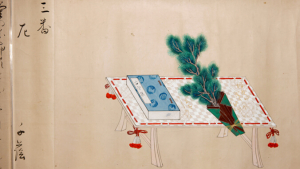
Reviving elements of art from the past is not something that is only tied to our present. There are times in history when cultures have recognized the importance of ensuring that certain practices are not lost.
On September 15 at Hamilton Library, scholars took a look back in time when the Japanese people sought to reclaim elements from the country’s golden age of literature and art. During the 18th century, uta-awase or poetry contests were reintroduced in Japan in an attempt to revive the celebrated Heian period (794–1185).
- Related UH News story: Classical Japanese poetry contest inspires UH Mānoa students, December 20, 2022


One 10-round contest in particular which required players to compose poems that pitted the literary qualities of bell crickets (suzumushi) and pine crickets (matsumushi) against each other, is documented on a set of post-medieval scrolls called “Jūban Mushi-awase” (Insect Contest in Ten Rounds). The two-scroll set is housed at the Honolulu Museum of Art (HoMA). Faculty and staff from the University of Hawaiʻi at Mānoa Department of East Asian Languages and Literatures (EALL) were tasked with translating the scrolls’ hard-to-read cursive style text and lavish paintings which depict live insects featured in table-top displays the uta-awase contestants constructed to present their poems.
“It is satisfying for our students to know that the work they put into this translation can be used by the museum whenever it displays the scrolls or makes them available to researchers,” said Robert Huey, an EALL professor emeritus internationally recognized for his expertise in classical and medieval Japanese poetry. “The scrolls themselves may seem effete, even out of touch, but their focus on reviving an ancient past was part of a growing intellectual movement to shake off the oppressive feudalism of the Tokugawa shogunate, which led, ironically, to the Meiji Restoration and Japan’s rapid modernization in the 19th and 20th centuries.”
At the workshop, Huey gave a historical overview of poetry contests and examined in detail how the text and image in three of the entries worked with each other in the scrolls and also intertextually with Japanese literary works from 900 years earlier.
Deciphering history

Since 2021, the translation project has brought together scholars out of EALL such as Huey, Assistant Professor Andre Haag, PhD students Hilson Reidpath, Tanya Barnett and alumna Francesa Pizarro with researchers from Japan and HoMA. The scrolls are part of the Lane collection, which is approximately 11,000 Japanese paintings, woodblock-printed books and manuscripts collected by late art dealer Richard Douglas Lane, a UH Mānoa alumnus.
The team from UH Mānoa has produced an English translation of the scrolls and penned short essays on some aspects such as text, paintings and historical elements. Reidpath, an EALL graduate student and aspiring professor was among those who presented some of the project’s findings at the workshop. He recalls how complex translations were for him in the beginning.
“It is quite satisfying to be here a few years later after that long afternoon in Moore Hall [in 2020] where we struggled to read a few characters,” Reidpath explained.
Samurai ties, patrolman

A research deep dive into the rare scrolls revealed many of the Japanese aristocrats who competed in the 1782 contest were novice writers. A patrol officer, legal officer and the daughter of a local samurai family were among the competitors. Researchers were only able to discover the woman’s first name, Yasoko. She was one of two females who competed.
Translation of Yasoko’s poem
In the field / of many maiden flowers / the voice of the pine cricket /
intently waiting for someone – / its chirp unrelenting.
Vault visit
This September, HoMA welcomed the Japanese scholars involved in the ongoing collaborative research project inside the museum’s vault to examine the scroll set inch-by-inch for the first time. Headed by Professor Morita Teiko (Kyoto Sangyō University), Iikura Yōichi, a professor emeritus (Osaka University) and joined by other researchers such as Matsumoto Ōki, an associate professor (Kansai University), they presented their findings at the Hamilton Library workshop which included some specifics on the contestants and how the event paid homage to the Heian period.
UH Mānoa continues to pursue other collaborative projects with researchers in Japan and HoMA. Minami Kiyoe, who oversees the Lane Collection at the museum, works closely with the UH and Japan research teams.
- Related UH News story: Hamilton Library houses rare poetry scroll from medieval Japan, September 7, 2023
HoMA will be exhibiting the scrolls in spring 2024 as part of a larger exhibit on the enduring impact of the Heian period in Japanese literature and art. A book featuring the English translation, a modern Japanese translation, and detailed scholarship on the scrolls in English and Japanese is also expected in 2024, to coincide with the HoMA exhibit.
EALL is in the UH Mānoa College of Arts, Languages & Letters.
All images of paintings in this article are from the Collection of the Honolulu Museum of Art. Purchase, Richard Lane Collection, 2003 (TD 2011-23-415).

